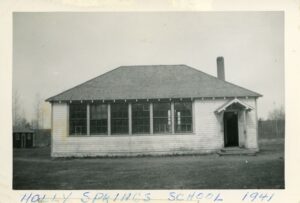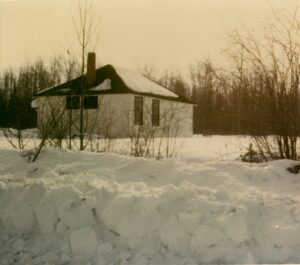The Log Schools
The first school in the Holly Springs area was a log building built in 1916. The school was named after a settlement of Black Americans, who settled in the district around 1910 from Holly Springs in the United States.
Students in this building used long benches instead of desks; one bench would be short, to sit on, with the other being tall, to work on. The “blackboard” was a piece of rough wood covered in tar paper. The school was soon abandoned as settlers moved away, and later burned down. The area was resettled throughout the 1920s, largely by Ukrainian and Swiss immigrants.
In 1926, Tom Tuttle and Joe Jackson constructed a second log structure to be used as a school. It was chinked (insulated) with moss, and was once again given the name “Holly Springs,” in remembrance of the abandoned school. The first teacher, Miss Rogers, stayed for only thirteen days, much to the annoyance of the chairman, who had to collect her 13-day salary from the ratepayers.
Teachers
Mr. Young
Miss Rogers
Mr. McFarland
Mr. Bailey
Ms. Leona Suggett
Miss Paskins
Mr. Elmer Hepburn
Ms. Edna Hutchinson
Miss Bertha Parker
Miss Gertie Webb
Ms. Jean Blair
Ms. Olga Drozdiak
Ms. Jean Pilkington
Ms. Gladys Smith
Ms. Florence Brenenstuhl
The last holly springs school
In 1941, this final Holly Springs school building was built by Adam Maguire of the Reno District. While in operation, the school had no library books, instead borrowing from Ms. Hutchinson’s personal collection. There was no dustpan, either; according to Mrs. Pilkington, the last Holly Springs School teacher, “when the floor was swept from east to west, the dirt went down the cracks in the floor.” The central heating system was an oil drum, which was turned into a stove by Pete Bura. A second stove, an airtight heater, was added later.
The school yard was not cleared until three or four years after the building was constructed. Because of this, goats often took the opportunity to stare into the windows at the students. As well, portions of the outside walls were plastered in mud, in hopes that this would prevent the mice from getting in.
The schoolhouse closed in 1956, and became a community centre for the district until it was relocated to museum grounds.

